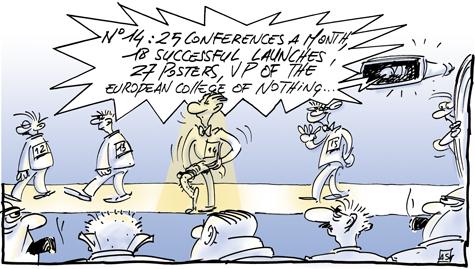
An American business consultancy that offers drug companies strategic advice has conducted a survey focusing on the involvement of opinion leaders in commercial strategies to launch new drugs (a)(1). The survey included the major pharmaceutical manufacturers AstraZeneca, Aventis, GlaxoSmithKline and Wyeth.
The authors estimated that large drug companies spend an average of around 38 million dollars per drug on opinion leaders within the launch of a new drug. This represents nearly one-third of the entire launch budget for the average new drug.
According to the authors of the survey, “companies that take time to inform thought leaders on their new drugs forge their best advocates in the medical community. (…) Early involvement of a thought leader provides useful information for brand strategists to construct product identity” (1). This early involvement starts well before the beginning of comparative trials and, according to the survey, costs an average of 6.3 million dollars per product.
It is clearly in drug companies’ interests to maintain close relationships with opinion leaders. According to this consultancy company, the “rewards” are often financial. Invitations to three-star restaurants and society events no longer suffice. On their side, opinion leaders appreciate help with scientific publications, being associated with prestigious research work, and being kept informed of upcoming new drugs.
According to the consultancy company, “rewards” have to be proportional to the influence exerted by an opinion leader. Nationally or internationally renowned specialists, and especially those with ties to patient groups, can expect higher rewards than others.
Some opinion leaders probably fail to realise exactly what value they represent to drug companies (2). Yet their key role in promotional strategies is clearly outlined in all pharmaceutical marketing textbooks (b). Students of medicine and pharmacy should be informed of this situation early in their curriculum.
Similarly, patients, health professionals (including medical specialists) and journalists should question opinion leaders’ motivations and try to understand whose interests they are serving.
French legislation states that members of the medical profession who have ties to companies producing or using health products, or to companies offering commercial advice on the use of these products, must make this known to the public when they express their opinion at conferences or in the media. Unfortunately this law, passed in 2002, has not yet been implemented.
©Prescrire 2006
Prescrire Int 2006; 15 (81) : 31.
Notes:
a- The 142-page study report costs US $ 6995 (ref 3).
b- Extracts from training manuals on pharmaceutical marketing practices, and especially sections concerning opinion leaders, have been published in the French edition of our bulletin (refs 4,5).
References:
1- “Pharma brands earmark $38 million for thought leaders” Dépêche PRNewswire, 3 March 2005: 1 page.
2- Prescrire Editorial Staff “Do some French academic clinicians have interest in common with the pharmaceutical industry?” Prescrire Int 2005; 14 (79): 198-199.
3- “Pharmaceutical thought leaders: brand strategies and product positioning report”
Available at: http://www.pharmathoughtleaders.com, accessed June 7, 2005.
4- Prescrire Rédaction “Le marketing pharmaceutique”Rev Prescrire 1995; 15 (156): 784.
5- Prescrire Rédaction “Industrie. La publicitévue par les publicitaires” Rev Prescrire 2001; 21 (219): 544-545.
